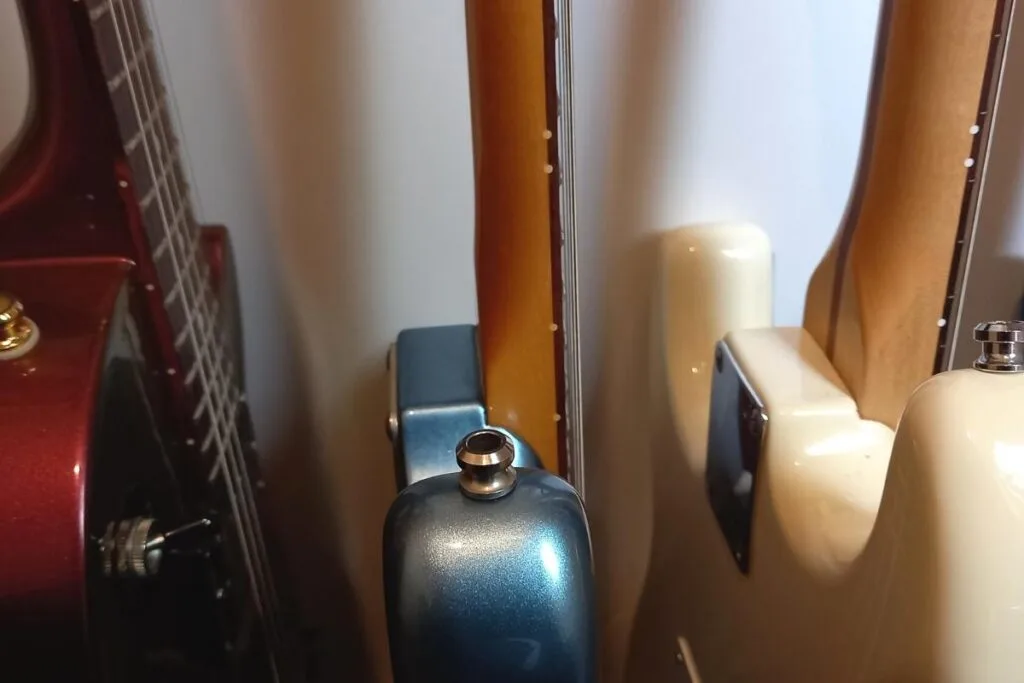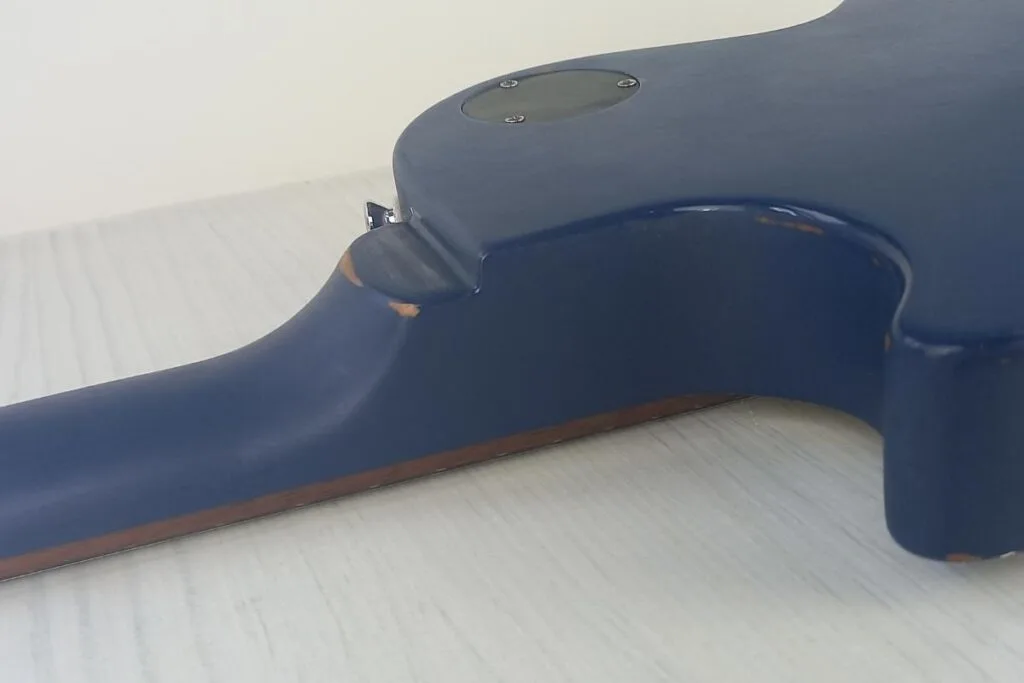There are almost as many guitar neck styles as there are guitars. Though there are specific fixed shapes, they can differ in depth, or thickness. This can impact how comfortably guitarists can play different guitars, and some even claim that they may affect the guitar’s tone. Let’s look more closely into the particular aspect of guitar neck thickness.
The thickness of a guitar neck is measured in inches from the front (fretboard) to the back. Different types of guitars have varying depths. Most guitarists prefer a particular thickness over others, but primarily for comfort as the thickness makes little difference in sound quality.
You may love either a thick neck or a thin neck guitar, and that preference is up to you. But if you’re trying to filter through all the contrasting views and opinions before buying or modifying your guitar, here are a few facts about neck thickness that you can consider while making your decision.
How important is guitar neck thickness?
The thickness of a guitar’s neck is one of the determining factors in whether you will be comfortable playing a particular guitar. But the thickness of a guitar’s neck doesn’t affect only the comfort of the guitarist. It can have a very slight impact on the overall sound.
Now, this is a widely-debated question, and most guitarists and luthiers have an opinion one way or another. The problem is that it’s difficult to test accurately as every player’s different!
From a logical perspective, you’d expect there to be at least a slight difference in sound. A thicker neck has more material that affects things like sustain and resonance (again, this is also highly debated!). So a thicker neck should sound a little different than a thinner neck.
That being said, the difference will be so slight that it’s really not worth thinking about. Factors like your guitar’s pickups, the strings you use, and even the wood it’s made from will have a much larger effect on your sound than neck thickness.
But, if the neck doesn’t feel right – it can affect how you play, which does affect your sound.

Comfort and playability
The main difference that the neck thickness makes is how comfortable the guitarist can play it. As mentioned, this is different from player to player.
Finding the right guitar neck can make playing guitar a breeze. Likewise, having the wrong type of neck can make playing feel like a chore.
You’d think that a guitarist would be able to know how comfortable a neck is just by the thickness – but that’s not always the case. Factors like a guitar’s fretboard radius and the guitar’s neck shape are all equally as important things to consider.
So, neck thickness itself isn’t the best measure of comfort, but it plays an important part. If you’re in doubt, I always recommend going to your local guitar store and having a play with different guitars. At the end of the day, it’s the only way to properly find the right type of neck for you.
How to measure guitar neck thickness
Guitar neck thickness is typically measured in inches, from the fretboard on the front to the back of the neck. Guitar manufacturers usually don’t provide this measurement of thickness. Instead, they provide the “nut width”, which is the width of the neck, as opposed to the depth.
To measure your guitar’s neck thickness or depth, you’ll need calipers. This is a special measuring device that looks like a vice grip.
Measurements are taken on the nut side of the neck (just before the headstock). This measurement is called the “nut width”. Some manufacturers, like Gibson, provide you with two sizes: the nut width and the “end of board width”. The latter is a measurement of the thickness around the 12th fret, where the guitar begins to join the body.

You must remove your guitar’s strings from the fretboard before measuring as the calipers need to go over the fretboard. Otherwise, you’ll throw off your measurement by measuring your strings, too. Maybe not a lot, but it’s still significant.
- After removing the strings, place the calipers over the top of the fretboard.
- Your calipers should be placed on the first fret, closest to the nut, positioned in the space between where the D and G strings are supposed to be.
- Take the measurement.
- Remove your calipers and repeat the process on the last fret before the “heel” of the neck (usually around the 12th fret).
You can now use these measurements to get a better understanding of your preferred neck thickness. If you don’t have access to calipers, then check your guitar manufacturer’s website. Most manufacturers will have these details listed under “specifications”.
Neck thickness of different guitar types
Every person is unique, and so is their neck thickness preference. That’s why guitar manufacturers have so many different makes and models of guitars available. As such, there’s a wide range of neck thicknesses.
Let’s take a look at the common neck thicknesses of three types of guitar.
Electric guitars
Electric guitars have the thinnest average neck thickness of all guitar types. They range between 0.750 and 0.900 inches. Though it is possible to get a thicker neck, it is uncommon on most electric guitars.
Any thinner than this, and the guitar neck may be susceptible to breaking under the pressure of the strings! A traditional truss-rod alone won’t be enough to counter the pressure. For this reason, luthiers usually include an internal stabilizing graphite bar with thinner necks. This bar helps to straighten the neck and adds some much-needed support.
Acoustic guitars
Acoustic guitars have an average neck thickness of between 0.846 and 0.945 inches. It’s common to find even thicker necks on acoustic guitars, but thinner necks are not so common.
The reason why a thicker neck is more common on acoustic guitars is because of the way acoustic guitars are played. The player’s thumb is pressed against the back of the neck while the other fingers wrap around the neck and onto the fretboard. A thicker neck is generally more comfortable to use in this position, and the playing style feels more natural.
The density of the steel strings commonly used on acoustic guitars also has a slight impact on the neck thickness. Thicker necks tend to bend less easily than thinner necks, and since steel strings may put a lot of force on the neck, it’s better to have a thicker neck rather than a thinner one.
Some luthiers also claim that one of the reasons for a thicker neck on acoustic guitars is a matter of convenience; a thicker neck is easier to attach to the thick, hollow body of an acoustic guitar.
Classical guitars
The average neck thickness of a classical guitar ranges between 0.845 and 0.916 inches. This is slightly thinner than the average neck thickness of an acoustic guitar. It may not seem like much, but it makes a massive difference to those who frequently play on both guitar types or are used to playing on one and then switching to the other.
One reason the neck is thinner is that classical guitars generally use nylon strings. These place less strain on the neck of the guitar.
The more important reason, though, is because of the way the classical guitar is played. The nylon strings are thicker than steel strings, which also makes the neck of the guitar wider (more space between the strings). Classical guitars are perfectly made for picking and other finger-style guitar playing.
To enhance the comfort of these types of guitar playing, the thumb of the guitarist wraps around the back of the neck instead of pressing against the neck. This makes the flatter neck ideal. From discussions on online guitarist forums, it’s clear that most classical guitarists prefer a thin neck.
Looking beyond guitar neck thickness
Apart from the thickness of a guitar’s neck, but closely related to it, another factor that affects a guitarist’s choice of guitar neck is the shape. If we look at any guitar neck thickness comparison chart, we see that specific shapes are indicated on the chart along with thickness or depth specifications.
No guitar neck is a perfect square or rectangle. There are no sharp corners on the neck of a guitar. All necks are curved to some extent, getting thicker towards the middle as they bend away from the fretboard. These curves can be sharper or more gradual (rounder).
The most common shapes are the U, V, D, and C shapes, and the neck’s curves resemble the letters representing the shapes. There are different thicknesses for all neck shapes, but generally speaking, the C and D shapes lean themselves more towards thicker necks since the neck reaches its maximum thickness much more quickly than with the U and V shapes.
Guitarists who prefer playing on thicker necks tend to prefer D- or C-shaped necks because the thickness is more evenly balanced across the neck.
For more information, check out this post from Fender.
Conclusion
Guitar neck thickness may not be the most crucial thing to consider when buying a guitar. It is more based on convenience and comfort since other factors have far more impact on sound than the neck thickness. But it is essential to be comfortable with your guitar, so it’s wise to play around with various guitars and see which neck thickness and shape you prefer.


Conor is a music producer, multi-instrumentalist, and all-round enthusiast from the UK with over 15 years of experience. He’s the founder and sole-content creator for the roundtable audio blog and YouTube channel.
